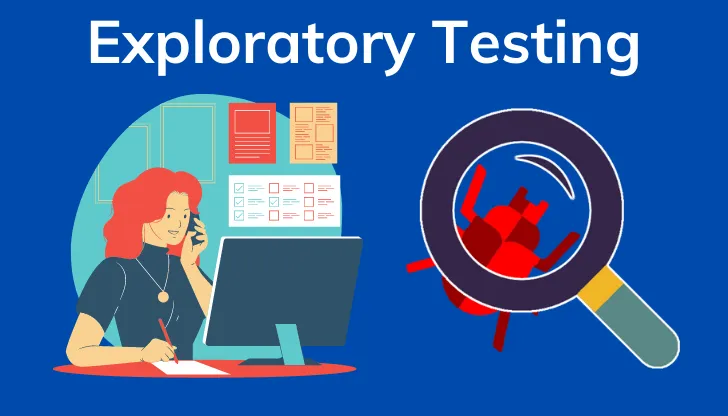
How can you use exploratory testing to learn from unexpected issues?
Over time, Quality Assurance has progressed into an integral part of the software development procedure, aimed at proactively addressing challenges that may arise during release. One approach that stands out for its capability to uncover the unexpected and boost product consistency is exploratory testing. Unlike old scripted testing techniques, exploratory testing is a dynamic approach that actively mitigates unexpected challenges that may arise during software development.
It is not about following predefined scripts but about embracing the changeable nature of software and consumer behavior. This approach is a robust tool for learning from unpredicted issues, which can be elusive while following solely script testing. In this article, we will delve into its overview of exploratory testing, best practices, and how it can be effectively harnessed to unearth issues that may go unnoticed.
Exploratory Testing: A Brief Overview
Exploratory testing is an approach or technique in testing that encourages QA testers to explore the software, interact with it, and concurrently design and implement test cases. Instead of following pre-determined test scripts, QA testers depend on their creativity, intuition, and familiarity to discover flaws, vulnerabilities, and usability concerns. This kind of testing isn’t just valuable for finding predicted issues but excels in revealing unpredicted issues. By actively seeking out the unpredicted, we not only discover and fix instant issues but also gain a deep understanding of the system’s resilience and possible weak zones. This approach eventually contributes to a user-centric and robust product, fostering a culture of continuous enhancement in software development.
In a broader sense, this form of testing emerges as a practice that does not emphasize broad documentation. Instead, it depends on testers’ previous experiences. The word ‘EXPLORE’ inherently entails a purposeful quest for discovery and understanding. Hence, exploratory testing can be defined as a technique where testing is succinctly characterized as a simultaneous combination of learning, test design, and test implementation. The word ‘exploratory’ was introduced by Cem Kaner.
What are unexpected issues?
Unexpected issues are any defects, problems, or anomalies that you come across during testing that aren’t predicted by the specifications, requirements, or design of the system. Ambiguous or incomplete requirements can cause such issues, changes or updates in the system or its environment, miscommunication among stakeholders, bugs or flaws in the code or configuration, user behavior or feedback that varies from expectations, and external impacts or dependencies that affect the system. The influences of unexpected problems can range from slight glitches to major security breaches or functional failures. Besides, they can reveal new insights, information, or opportunities for perfection that weren’t considered before.
Why is Exploratory testing helpful to learn from unexpected issues?
This type of testing is beneficial for learning from unexpected concerns by letting you test the system accurately and mimicking how users would interact with it. You can easily detect and investigate the root causes, patterns, and effects of the problems through the use of different tools such as Selenium, Appium, and Playwright and techniques such as monitors, debuggers, logs, or analyzers.
Here’s how you can harness the potential of exploratory tests to learn from and address those unexpected challenges.
- User-Centric Approach: This form of testing closely simulates how end-users interact with the software application. QA testers put themselves in the users’ shoes, attempting various scenarios and paths. This user-centric approach sometimes unveils usability problems that old forms of testing might miss.
- Real-Time Adaptation: QA engineers adapt and adjust their test strategy on the fly. They explore distinct parts of the software that might not be covered in scripted tests, replicating real-world consumer behavior. This realistic testing procedure often results in the discovery of problems that scripted testing wouldn’t encounter.
- Scenario Creation: QA testers produce scenarios that mimic real-world conditions. By doing this, they can uncover unpredicted interactions between distinct software elements or user activities, aiding in identifying subtle flaws.
- Exploring Edge Cases: One of the prime benefits of exploratory tests is the excellence in discovering edge cases and corner scenarios. QA engineers might stumble upon unpredicted conditions or inputs that can reveal security susceptibilities or other issues.
- Gaining Insights from Experience: Skilled testers often depend on their deep domain know-how and prior testing experience. This background enables them to recognize patterns, potential threats, and deviations from projected behavior that may not be apparent to scripted testing.
Close the Loop with LambdaTest
To make exploratory tests even more effective, consider incorporating LambdaTest into your test strategy. LambdaTest is an AI-powered test orchestration and execution platform that provides an extensive suite of real browsers and OSs for testing. This means one could easily explore the software applications in varied environments, simulating real-world customer situations and uncovering glitches across distinct configurations.
With LambdaTest, you can flawlessly run exploratory testing, accessing the resources and tools required to boost your test capabilities. It’s a game-changer for uncovering and addressing unpredicted concerns that might be ignored in your software.
In simple words, integrating exploratory testing into your testing strategy, and using a platform like LambdaTest, can ensure your software is reliable, robust, and user-friendly.
What are the challenges of exploratory testing?
Exploratory testing can be a dynamic approach to QA and software testing, but it does come with its suite of challenges. Let’s explore some of the common challenges linked with exploratory testing:
- Limited Reproducibility: As exploratory testing relies on the QA engineer’s creativity and intuition, it can be tricky to reproduce exact test cases. This makes it tough to retest the exact issues or examine if the same situations will lead to the same issues.
- Lack of Documentation: This form of testing sometimes involves least or no documentation, which can be tricky and challenging when it comes to traceability and sharing test outcomes with the QA group.
- Resource-Intensive: Exploratory testing can be arduous, time-consuming, and resource-intensive when compared to scripted tests. Testers need an in-depth understanding of the software, which needs continuous training & domain knowledge.
- Difficulty in Comprehensive Coverage: While this type of testing is brilliant at discovering certain forms of issues, it may not be as effective at attaining all-inclusive test coverage. Testers may overlook particular scenarios during exploration.
- Difficulty in Complicated Systems: In intricate software systems, exploratory testing can become overwhelming because of the sheer number of possible circumstances. Keeping track of the combinations of conditions and inputs can be tricky and hard.
- Scalability Issues: Scaling exploratory tests for big projects or distributed software testing teams can be intricate. Managing efforts and sharing insights across varied test sessions could be a logistical challenge.
- Difficulty in Formal Reporting: This form of testing may not offer structured reporting suitable for compliance or auditing purposes. This can be tough in highly regulated sectors.
Best Practices for Exploratory Testing
- Clear Goals: Define the objectives of your exploratory test session. What are you targeting to uncover? This clarity assists QA testers in focusing on their exploration.
- Comprehensive Documentation: Keep explained notes of your test session. Document what you have done, what you saw, and any unusual behaviors or defects you encountered.
- Collaboration: Encourage collaboration among your QA team. Diverse testers bring different expertise and perspectives, enhancing the likelihood of exploring unexpected issues.
- Structured Testing Sessions: While this type of testing isn’t clear, it’s beneficial to have structured sessions while you focus on particular facets or functionalities of the software.
- Continuous Enhancement: Review and learn from your test sessions. What did you find, and how can the procedure be refined for good outcomes in the future?
What are the advantages of Exploratory Testing?
- Speedy Bug/ Error Detection: This type of testing is adept at quickly uncovering flaws and issues in the software. QA engineers actively explore the app, and their real-time communication often results in the swift detection of issues.
- Effective for Ad Hoc Tests: When time is restricted or formal test cases are inaccessible, exploratory testing is extremely effective. QA’s can rapidly adapt to the circumstances and start exploring the software applications, ensuring comprehensive coverage.
- Increased Test Coverage: This form of testing enables complete test coverage as testers dynamically explore different conditions, paths, and functionalities within the app. This naturally results in a broader choice of testing scenarios.
- Uncovering Unpredicted Issues: It excels in detecting concerns that might not be covered by scripted test cases. QA engineers can stumble upon edge cases, unpredicted scenarios, and usability issues that scripted testing may miss.
- User-Centric Tests: Testers simulate real-time user interactions, which means the testing resembles closely how users will utilize the software. This user-centric tactic assists in detecting usability problems, giving valuable perceptions of the user experience.
- Exploration of Real-World Scenarios: QA’s can generate test scenarios that closely mimic real-world user behavior and circumstances, increasing the possibility of discovering problems that would occur in the field.
- Adaptive Testing: QA specialists can adapt their method in real time based on what they notice during the test. This means they can dive deep into parts of concern or prioritize testing based on their discoveries.
- Encourages Creativity: This form of testing also encourages testers to think innovatively, which can result in the discovery of exceptional test cases and glitches. It lets QA testers use their expertise and instincts in real time.
- Efficient Learning: Testers can additionally learn about the software’s idiosyncrasies and nuances rapidly. This knowledge is precious for generating perfect test cases, finding potential threats, and enhancing the overall testing strategy.
- Cost-Effective: This form of testing can be a lucrative approach, chiefly when there is a restricted financial plan or tight timelines. It reduces testing effectiveness by focusing on high-risk zones.
- Feedback-Driven Enhancement: Exploratory testing sessions also offer valuable feedback that can be utilized to upgrade future testing efforts. This iterative procedure results in constant enhancement in the testing process.
Complementary to Other Testing Approaches: This type of testing complements other testing techniques such as scripted testing and automated testing. It uncovers problems that may be missed by other methods.
Conclusion
In a nutshell, exploratory testing is a valuable addition to any test strategy, specifically because it excels in uncovering unpredicted problems. By simulating real-world usage and relying on skilled testers, this tactic reveals vulnerabilities and defects that old forms of testing may overlook. Embrace the customer-centric, adaptive nature of exploratory tests to learn from the unpredicted and enhance the overall quality of your software.
Integrate exploratory testing into your software test strategy, and with the aid of LambdaTest, you will be better equipped to learn from unpredicted issues. Make certain your software is reliable, dynamic, and user-friendly, and stay one step ahead in the ever-progressing world of QA testing.







